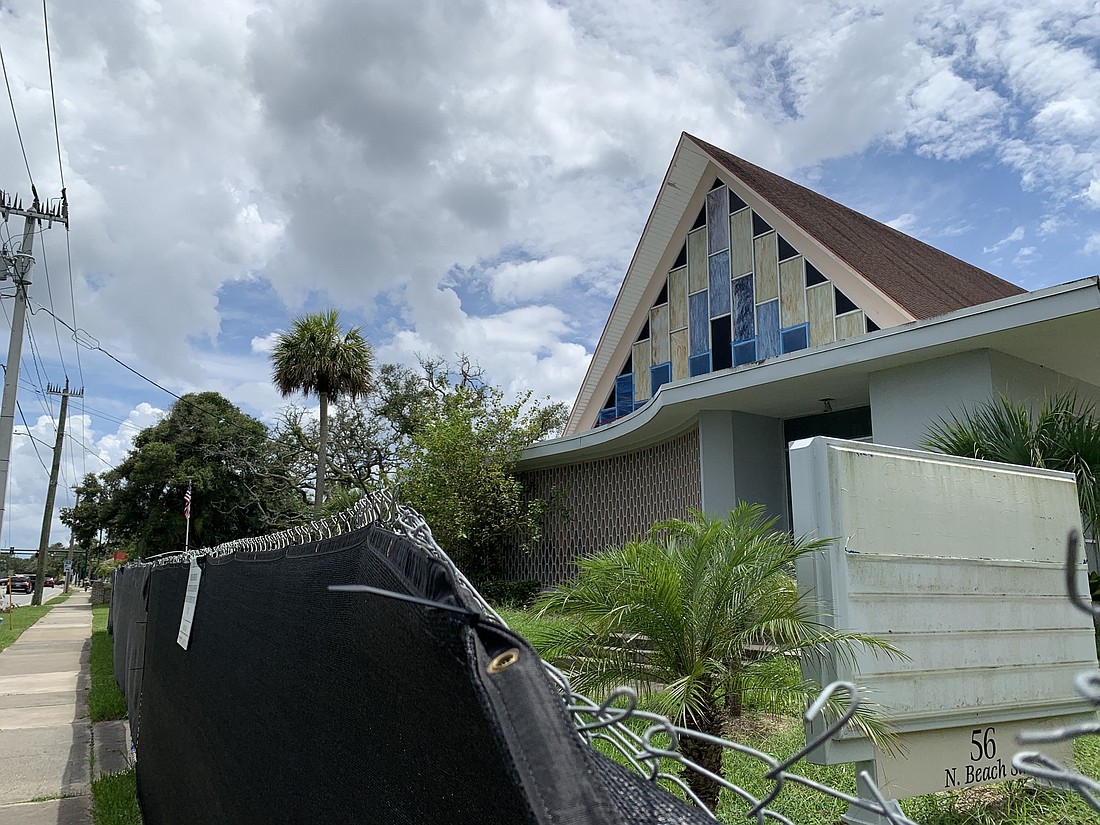- December 15, 2025

Updated 12:30 p.m. July 15, to show that the cost of demolition is included in the additional $129,579. The story originally said that sum was for the parking lot alone.
Unswayed by 100 emails, 25 public speakers and two impassioned pleas by their colleagues, City Commissioners Troy Kent, Susan Persis and Rob Littleton stood firm in their decision, at a July 13 special meeting, to demolish the former Union Church on North Beach Street.
Of the 25 who signed up to speak July 13, many were leaders of civic organizations, one was a childhood attendee of the former Union Church, and one said he married his wife there. The residents were united in asking for a six-month delay to explore options for saving the building or finding new uses for the property.
Many in the audience saw the 1960 church as a historic asset for the city, comparing it with The Casements and the Anderson-Price Memorial Building next door. "Once it's gone, it's gone forever," said former Planning Board member and longtime community activist Rita Press.
On May 4, the commission voted 3-2 (City Commissioner Dwight Selby and Mayor Bill Partington dissented) to demolish the building and construct a temporary, shell parking lot, but a public outcry inspired Partington to call the July 13 meeting.
The city had purchased the property, which includes a riverside parcel, in 2018 for $729,000. The demolition and parking lot combined will cost another $125,579, according to city documents.
City Commissioner Dwight Selby and Mayor Bill Partington tried to change Littleton's mind on July 13, but Littleton said the time to propose a viable use for the church had passed. No good plan has been proposed since it was purchased in 2018.
“I was looking for a justification to change my vote,” Littleton said. That justification would have been in the form of “a plan, with money attached in some way, and I didn’t hear it tonight.”
Selby gently pressed Littleton, asking, "What's the rush" to demolish the building? And, considering the delays in public process due to the pandemic, Selby said, “This is the first opportunity they’ve even had to begin to tell us [a plan].”
The crowd erupted in applause, and Selby continued trying to persuade Littleton: “I think we owe it to them to let them come up with a plan and see whether or not it’s good enough.”
Littleton’s rebuttal was that, after three years, delaying further was “a fool’s errand.” He said it’s time to turn the property into something useful for the community.
Partington said that of 100 emails he’d received on the subject, only two or three were in favor of tearing down the church.
“Overwhelmingly, our residents want to do something that saves that property as a public use in some form or fashion,” he said. “It’s dangerous not to listen to our residents. … I would hope that someone [on the commission] would change their mind.”
In his final comments, Partington again told Kent, Persis and Littleton: “Ignoring the voice of the people, not listening to your residents, is a very dangerous, dangerous thing to do. … This is an opportunity to be a hero or not.”
Many of the residents said they had taken tours of the church and had concluded that renovating it might cost less money than the city’s previous presentations had suggested. But Persis felt the opposite.
Three construction experts had toured the church with her recently, she said, and they pointed out many problems: termites, rodents, asbestos, unsalvageable windows and doors. Moreover, she said, although it may have been designed by a renowned architect, “The building was built at a cheaper cost.” For example, the colorful glass in the A-frame is not actual stained glass — “it’s just painted.”
Persis wants to put the property to good use for the city, she said, and demolition is unavoidable.
“I feel like it’s my responsibility,” she said. “I don’t want anyone in there. Because it’s a sick building; it needs to be torn down.”
Kent also was unswayed by the residents’ wishes. “After seeing what the consultants shared with us, I don’t believe that property is going to work for a community center,” he said, due in part to a lack of parking.
Like the other commissioners and the rest of the audience, Kent said he doesn’t want the property to become a parking lot in the long term, however. He suggested that the best outcome could be to sell the property at a profit for the city.
He said that although the residents are the “bosses” of the commissioners, the tough decisions ultimately have to be made by the commissioners.
Partington’s father, Bill Partington II, was one of the harshest critics. He said: “It’s time to admit that this could have been handled better, and delay the demolition until a study can be conducted.”
Others blamed the city for letting the building fall into disrepair.
Many also praised the city for holding the special meeting July 13 to listen to them, and Selby praised the residents for their civility.
“This is what makes Ormond Beach great,” Selby said. “This is the fabric of Ormond Beach, because people care about our city.”
Some, disappointed and frustrated as they exited City Hall, vowed to keep up the fight.